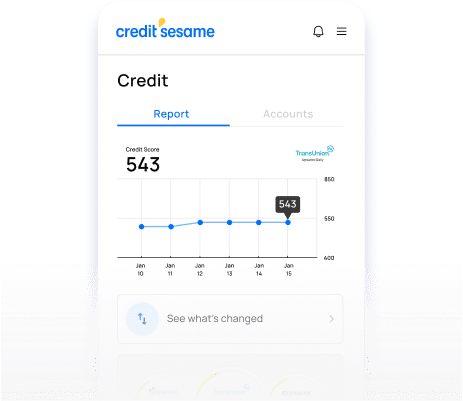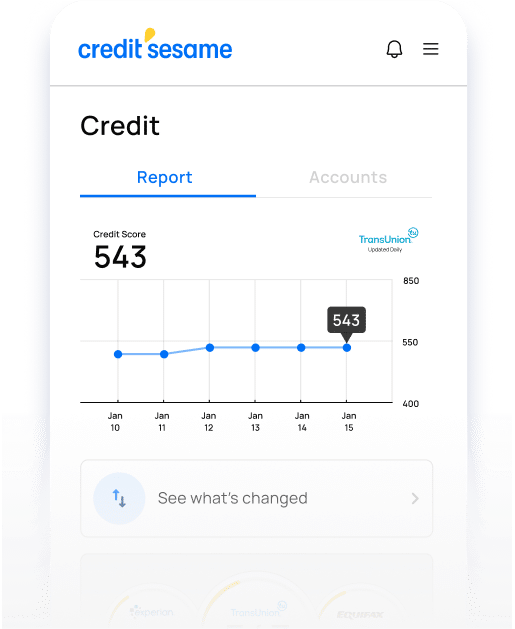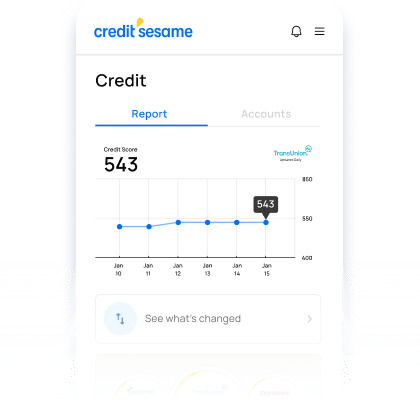The value of seeing your full credit picture
Seeing and understanding your full credit picture empowers informed financial decisions. It allows you to identify inaccuracies, manage debt responsibly, and negotiate better terms. A comprehensive view of your credit health fosters improved credit management and financial well-being.

Get your FREE credit report summary
See the factors impacting your credit score and what you can do about it. 100% free.
By clicking on the button above, you agree to the Credit Sesame Terms of Use and Privacy Policy.
- ON THIS PAGE
- What are the three major credit reports?
- Are the credit reports from the three bureaus the same?
- Who uses the three credit reports?
- Is it useful to review information from all 3 bureaus?
- Is it easy to cross-reference data in the 3 credit reports?
- How does Sesame Ring™ simplify 3-bureau report analysis?
- What does the Sesame Grade™ mean?
- In a nutshell
Share this
What are the three major credit reports?
The three major credit reports in the USA are generated by the three major credit reporting agencies (credit bureaus), TransUnion, Experian and Equifax. Each of these credit bureaus maintains an individual credit report for consumers. Information reported to and gathered by the reporting agencies is used to compile credit reports. Lenders and other institutions use these reports to assess your creditworthiness when you apply for credit, such as loans, credit cards, and mortgages.
- TransUnion credit reports contain information about your credit accounts, payment history, credit inquiries and any relevant public records. Data is collected from various sources and compiled into credit reports that help lenders assess consumer creditworthiness. Consumers may also use them to review and manage their credit and financial health.
- Experian credit reports include comprehensive data and information pertaining to your credit history. This includes details about your credit accounts, payment history, inquiries, and public records. Experian collects and maintains credit information from lenders and other sources to generate credit reports, which may be used by lenders to assess credit risk and individuals for credit management.
- Equifax credit reports also contain information about your credit history, credit accounts, payment history, credit inquiries, and public records (if applicable). Lenders, creditors, and other authorized entities report your credit activity to Equifax and use the information to assess creditworthiness. Individuals may access the information to understand their credit status.
Are the credit reports from the three bureaus the same?
The three credit reports generated by the three major credit reporting agencies (Equifax, Experian, and TransUnion) are not the same. They contain similar types of information, but there can be differences between them. Here are some reasons why the three credit reports are not identical:
- Data reporting. Lenders and creditors might not report to all three credit bureaus. Some lenders report to only one or two of the bureaus, which can lead to variations in the information included in each report.
- Timing of reporting. The timing of when lenders report your credit activity can differ. For example, a credit card payment you make in a particular month might be reported to one bureau before it’s reported to another.
- Errors or inaccuracies. Errors can occur in the reporting process. While credit bureaus strive for accuracy, there’s a possibility that a lender might report incorrect information to one bureau and not to others.
- Public records and collections. If you have any public records, such as bankruptcies or tax liens, or if an account has been sent to collections, these events might not be reported to all three bureaus at the same time.
- Scoring models. Each credit bureau uses its own scoring model to calculate credit scores. While the factors influencing your score are similar, the specific calculations might differ, leading to variations in credit scores across the bureaus.
- Credit inquiries. Each credit bureau records inquiries made on your credit report. However, some inquiries might be reported to only one or two bureaus, leading to differences in the number of inquiries on each report.
Who uses the three credit reports?
While there is overlap in the types of users, there can be some differences in who uses each report based on regional preferences and business relationships.
- Lenders and creditors. Banks, credit unions, and credit card companies use credit reports to evaluate the risk of lending money to individuals. They assess your credit history and credit scores to determine the terms of credit offers, including interest rates and credit limits. Some lenders might have preferred relationships with specific credit bureaus and primarily use reports from those bureaus for their lending decisions.
- Landlords. Landlords use credit reports to screen potential tenants and assess their financial reliability. A credit report can provide insights into an applicant’s payment history and financial responsibility.
- Employers. In some cases, employers may request permission to access your credit report as part of the hiring process, especially for positions that involve financial responsibility or access to sensitive financial information.
- Insurance companies. Insurance providers, particularly for auto and home insurance, may use credit reports to help determine insurance premiums. Research suggests a correlation between credit history and the likelihood of filing insurance claims.
- Utility Companies. Some utility companies, including providers of electricity, gas and telecommunications services, might check your credit report when setting up new accounts. A positive credit history could result in better terms or avoid certain security deposits.
- Government agencies. Government agencies dealing with tax collection or certain licensing processes, might use credit reports to assess an individual’s financial standing.
- Financial institutions. Beyond lending, financial institutions like credit unions and banks may use credit reports to determine eligibility for financial products or services.
- Individuals. Individuals, including yourself, can access your own credit reports to monitor your credit health, check for inaccuracies, and ensure that your financial information is up to date.
Specific users accessing credit reports from each bureau vary based on factors such as local laws, business relationships, and industry regulations.
Is it useful to review information from all 3 bureaus?
Reviewing your credit information from all three bureaus is an important step in credit and financial health management. If you are making a major financial decision, such as applying for a mortgage or loan, it is important that your credit information is accurate and up to date.
Assessing information and data from each of the three major credit bureaus (TransUnion, Experian and Equifax) involves a systematic approach to ensure accuracy, consistency, and a comprehensive understanding of your credit situation. Typically, there are several steps to reviewing all your credit information and data.
- Obtain your credit reports from all three bureaus. You are entitled to one free copy of each report annually from AnnualCreditReport.com. Review the reports individually, focusing on the details of your accounts, payment history, inquiries, and any other relevant information.
- Compare and cross-reference information across the three reports. Look for any inconsistencies or discrepancies in account balances, payment histories, and other account details. Check that all your active and closed accounts are accurately represented on all reports.
- Verify your personal information, such as your name, address, and Social Security number, is consistent and correct across all reports. Discrepancies could indicate potential errors or fraud.
- Check for inaccuracies, such as accounts you did not open, missed payments that you believe you made on time, or incorrect account statuses. If you find any discrepancies, follow the dispute process to correct the information.
- Review credit utilization. Examine your credit card balances and credit limits for each account on all reports. Calculate your credit utilization ratio (credit card balances divided by credit limits) for each bureau. Ensure the ratios are consistent and within a healthy range.
- Review any public records, such as bankruptcies, tax liens, or civil judgments, on each report. Check if any negative items, such as late payments or delinquencies, are accurately reported.
- Compare credit scores from each bureau to identify any significant differences. Slight variations are normal due to different scoring models.
- Identify improvement opportunities. Prioritize actions that can positively impact all three bureaus, such as paying bills on time and reducing credit card balances.
- Regularly monitor your credit reports and scores from all three bureaus. Consider using free or paid credit monitoring services to receive alerts about changes to your credit.
- Take steps to correct inaccuracies, discrepancies and negative information.
- Focus on maintaining consistent financial habits. Timely payments, responsible credit utilization, and avoiding excessive new credit applications contribute to healthy credit across all bureaus.
By conducting regular reviews and addressing any discrepancies promptly helps ensure that your credit information is accurate and reflects your true financial situation.
Is it easy to cross-reference data in the 3 credit reports?
The process of cross-referencing information from each credit bureau can be cumbersome and time-consuming. Each credit bureau has its own format for reporting credit information, so it can be difficult to compare the information from different bureaus. Additionally, each credit bureau has its own rules for how long they keep certain types of information, so it is possible that there will be gaps in the information that you receive. Here are some of the challenges of cross-referencing credit reports:
- Different reporting formats. Each credit bureau has its own report format for credit information. This can make it difficult to compare the information from different bureaus.
- Incomplete information. Individual credit bureaus access only a portion of your credit history. This means that there may be gaps in the information that you receive.
- Errors. Credit reports can contain errors, which may be propagated with all three bureaus or not. This can make it difficult to track your credit history accurately.
How does Sesame Ring™ simplify 3-bureau report analysis?
Sesame Ring™ launched in August 2023 and is a new and innovative way for consumers to access and manage all their credit information. The free version includes the Sesame Grade™ based on credit score, data and information from TransUnion along with a personalized action plan, intelligent alerts and AI-driven customer support.
The paid Premium plan incorporates credit information from Experian and Equifax and a Sesame Grade™ that reflects overall credit health based on credit report data and information from all three credit bureaus.
Sesame Ring™ makes cross-referencing and comparing data between credit bureaus easy and intuitive. Consumers can expand each segment of the Sesame Ring™ to access more detail and suggested actions.


What does the Sesame Grade™ mean?
The Sesame Grade™ is an overall assessment of your credit and financial health taking into account available credit and financial data. It is a single grade that summarizes the five credit factors (payment history, credit utilization, length of credit history, credit mix and new credit applications) for TransUnion or all three credit bureaus, depending on which version of the app is used.
In a nutshell
By combining data from TransUnion, Experian and Equifax, the Premium app provides a holistic view of credit health for consumers. This full picture empowers consumers to detect discrepancies and inaccuracies promptly and provides intelligent alerts and action items. The simple and intuitive presentation enables easy comprehension of financial standing and aids credit and financial decisions. An assessment of credit information from different sources gives consumers the confidence to manage and improve their credit. The Sesame Ring™ is a useful strategic tool for maintaining financial well-being and navigating credit-driven endeavors.
A comprehensive 3-bureau credit report offers clarity and confidence. It unifies data, aiding accuracy and informed decisions. The unique perspective provided by the Sesame Grade™ and Sesame Ring™ empowers users to understand their credit situation and financial status and provides the key to unlocking better credit management and opportunities.

Get your FREE credit report summary
See your credit score and get insight into what’s impacting your credit
By clicking on the button above, you agree to the Credit Sesame Terms of Use and Privacy Policy.
Share this
More related articles

Get your FREE credit report summary
Understand your credit better with a free credit report summary
Value of credit reports
How to get a credit report
Reporting to credit bureaus
See your score and
credit report
summary.
See your score and credit report summary.
See the factors impacting your credit score
By clicking on the button above, you agree to the Credit Sesame Terms of Use and Privacy Policy.















